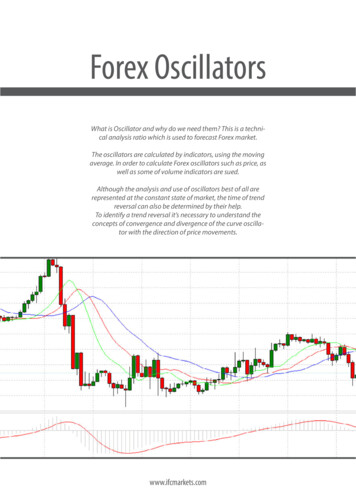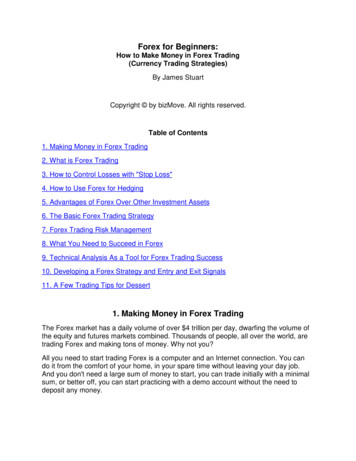
Transcription
Forex OscillatorsWhat is Oscillator and why do we need them? This is a technical analysis ratio which is used to forecast Forex market.The oscillators are calculated by indicators, using the movingaverage. In order to calculate Forex oscillators such as price, aswell as some of volume indicators are sued.Although the analysis and use of oscillators best of all arerepresented at the constant state of market, the time of trendreversal can also be determined by their help.To identify a trend reversal it’s necessary to understand theconcepts of convergence and divergence of the curve oscillator with the direction of price movements.www.ifcmarkets.com
Average True Range (ATR) IndicatorThe Average True Range (ATR) indicator was introduced by Welles Wilder as a tool to measure the market volatilityand volatility alone leaving aside attempts to indicate the direction. Unlike the True Range, the ATR also includesvolatility of gaps and limit moves. The indicator is good at valuating the market’s interest in the price moves forstrong moves and break-outs are normally accompanied by large ranges.The ATR is used with 14 periods with daily and longer timeframes and reflects the volatility values that are in relation to the trading instrument’s price. Low ATR values would normally correspond to a range trading while highvalues may indicate a trend breakout or breakdown.Average True Range (ATR) Indicator CalculationAverage True Range is a moving average of the True Range which is the greatest of the following three values: The distance from today’s high to today’s low.The distance from yesterday’s close to today’s high.The distance from yesterday’s close to today’s low.www.ifcmarkets.comClick here to share
Bollinger Band IndicatorPurposeThe Bollinger Bands indicator (named after its inventor) displays the current market volatility changes, confirmsthe direction, warns of a possible continuation or break-out of the trend, periods of consolidation, increasingvolatility for break-outs as well as pinpoints local highs and lows.UsageThe indicator consists of the three moving averages: Upper band - 20-day simple moving average (SMA) plus double standard price deviation.Middle band - 20-day SMA.Lower band - 20-day SMA minus double standard price deviation.The increasing distance between the upper and the lower bands while volatility is growing, suggests of aprice developing in a trend which direction correlates with the direction of the Middle line. In contrast to theabove, at times of decreasing volatility when the bands are closing in, we should be expecting the priceto move sidewards in a range.The price moving outside the Bands may indicate either the trend’s continuation (when the bands are floating apart as the volatility increases) or the U-turn of the trend if the initial movement is exhausted. Eitherway each of the scenarios must be confirmed by other indicators such as RSI, ADX or MACD.Anyhow the price crossing of the Middle line from below or above may be interpreted as a signal to buy orto sell respectively.Bollinger Band Indicator CalculationThe middle line (ML) is a regular Moving Average:ML SUM [CLOSE, N]/NThe top line (TL) is ML a deviation (D) higher:TL ML (D*StdDev)The bottom line (BL) is ML a deviation (D) lower.BL ML — (D*StdDev)www.ifcmarkets.comClick here to share
Commodity Channel Index (CCI) IndicatorPurposeThe Commodity Channel Index is an indicator by Donald Lambert. Despite the original purpose to identify newtrends, it’s nowadays widely used to measure the current price levels in relation to the average one.UsageThe indicator oscillates around the naught line tending to stay within the range from -100 to 100. The naughtline represents the level of an average balanced price. The higher the indicator surges above the naught line themore overvalued the security is. The further the indicator plunges into the negative area the more potential forgrowth the price may have.Still the unbalanced price alone may not serve as a clear indicator neither to the direction the price is followingnor to its strength. There are critical values and the crossing directions which need to be looked at closely: Exceeding past the 100 level suggests a possible further upward movement Decreasing past the 100 level indicates a U-turn and serves as a signal to sell. Decreasing past the -100 level suggests a possible further downward movement Exceeding past the -100 level indicates a U-turn and serves as a signal to buy. Crossing the naught line upwards from below serves as a confirmation to buy Crossing the naught line downwards from above serves a confirmation to sell.Smaller indicator period increases its sensitivity. Shifting critical levels to 200 allows to exclude insignificant pricefluctuations.Commodity Channel Index (CCI) Indicator CalculationA complete explanation of the CCI calculation is beyond the scope of this book. The following are basic stepsinvolved in the calculation:1. Add each period’s high, low, and close and divide this sum by 3. This is the typical price.2. Calculate an n-period simple moving average of the typical prices computed in Step 1.3. For each of the prior n-periods, subtract today’s Step 2 value from Step 1’s value n days ago. For example, ifyou were calculating a 5-day CCI, you would perform five subtractions using today’s Step 2 value.4. Calculate an n-period simple moving average of the absolute values of each of the results in Step 3.5. Multiply the value in Step 4 by 0.015.6. Subtract the value from Step 2 from the value in Step 1.7. Divide the value in Step 6 by the value in Step 5.www.ifcmarkets.comClick here to share
DeMarker IndicatorPurposeThis indicator was introduced by Tom DeMark as a tool to identify emerging buying and selling opportunities. Itdemonstrates the price depletion phases which usually correspond with the price highs and bottoms.The DeMarker indicator proved to be efficient at identifying trend break-downs as well as spotting intra-day entryand exit points.UsageThe indicator fluctuates with a range between 0 to 1 and is indicative of lower volatility and a possible price dropwhen reading 0.7 and higher, and signals a possible price increase when reading below 0.3.DeMarker Indicator CalculationThe DeMarker indicator is the sum of all price increment values recorded during the “i” period divided by the priceminima:The DeMax(i) is calculated:If high(i) high(i-1) , then DeMax(i) high(i)-high(i-1), otherwise DeMax(i) 0The DeMin(i) is calculated:If low(i) low(i-1), then DeMin(i) low(i-1)-low(i), otherwise DeMin(i) 0The value of the DeMarker is calculated as:DMark(i) SMA(DeMax, N)/(SMA(DeMax, N) SMA(DeMin, N)).www.ifcmarkets.comClick here to share
Envelopes IndicatorPurposeThe Envelopes indicator reflects the price overbought and oversold conditions helping to identify the entry orexit points as well as possible trend break-downs.UsageThe indicator consists of two SMAs that together form a flexible channel in which the price evolves. The averagesare plotted around a Moving Average in a constant percentage distance which may be adjusted according to thecurrent market volatility. Each line serves as a margin of the price fluctuation range.In a trending market take only oversold signals in an uptrend conditions and overbought signals in a downtrendconditions.In a ranging market the price reaching the top line serves as a sell signal, while the price at the lower line generates a signal to buy.Envelopes Indicator CalculationUpper Band SMA(CLOSE, N)*[1 K/1000]Lower Band SMA(CLOSE, N)*[1-K/1000]Where:SMA — Simple Moving Average;N — averaging period;K/1000 — the value of shifting from the average (measured in basis points).www.ifcmarkets.comClick here to share
Force Index IndicatorPurposeThe Force Index indicator invented by Alexander Elder measures the power behind every price move based ontheir three essential elements, e.g., direction, extent and volume. The oscillator fluctuates around the zero, i.e., apoint of a relative balance between power shifts.UsageThe Force Index allows to identify the reinforcement of different time scale trends: The indicator should be made more sensitive by decreasing its period for short trends.The indicator should be smoothed by increasing its period for longer trends.The Force Index may strongly imply a trend change:Break-down of an uptrend when the indicator’s value is changing from positive to negative and price andindicator show divergence.Break-down of a downtrend when the indicator’s value is changing from negative to positive and price andindicator show convergence.Together with a trend-following indicator the Force Index can help identify trend corrections:An uptrend correction when the indicator bounces off the low.A downtrend correction when the indicator slides from a pike.Force Index IndicatorCalculationForce Index(1) {Close (current period) - Close (prior period)} x VolumeForce Index(13) 13-period EMA of Force Index(1)www.ifcmarkets.comClick here to share
Ichimoku IndicatorPurposeThe Ichimoku Kinko Hyo (Equilibrium chart at a glance) is a comprehensive technical analysis tool introduced in1968 by Tokyo columnist Goichi Hosoda. The concept of the system was to provide an immediate vision of trendsentiment, momentum and strength at a glance perceiving all the Ichimoku’s five components and a price interms of interactions among them of a cyclical type related to that of human group dynamics.UsageThe Ichimoku indicator consists of five lines which may all serve as flexible support or resistance lines, whosecrossovers may as well be assumed as additional signals:1. Tenkan-Sen (Conversion line, blue)2. Kijun-Sen (Base line, red)3. Senkou Span A (Leading span A, green boundary of the cloud)4. Senkou Span B (Leading span B, red boundary of the cloud)5. Chikou Span (Lagging span, green)Kumo (Cloud) is a central element of the Ichimoku system and represents support or resistance areas. It is formedby Leading Span A and Leading Span B.Determining support and resistance: Leading span A serves as a first support line for an uptrend Leading span B serves as a second support line for an uptrend Leading span A serves as a first resistance line for a downtrend Leading span B serves as a second resistance line for a downtrendStrong Buy/Sell signals occurring above the cloud:Ichimoku Indicator Calculation Tenkan-Sen (Conversion line, blue) is (9-period high 9-period low)/2Kijun-Sen (Base line, red) is (26-period high 26-period low)/2Senkou Span A (Leading span A, green boundary of the cloud) is (Conversion Line Base Line)/2Senkou Span B (Leading span B, red boundary of the cloud) is (52-period high 52-period low)/2Chikou Span (Lagging span, green) is close price plotted 26 periods in the pastwww.ifcmarkets.comClick here to share
Moving-Average Convergence/Divergence (MACD) IndicatorPurposeMoving-Average Convergence/Divergence Oscillator, commonly referred to as MACD, is an indicator developedby Gerald Appel which is designed to reveal changes in the direction and strength of the trend by combiningsignals from three time series of moving average curves.UsageThree main signals generated by the indicator (blue line) are crossovers with the signal line (red line), with thex-axis and divergence patterns.Crossovers with the signal line: If the MACD line is rising faster than the Signal line and crosses it from below, the signal is interpreted as bullish and suggests acceleration of price growth;If the MACD line is falling faster than the Signal line and crosses it from above, the signal is interpreted asbearish and suggests extension of price losses;Crossovers with the x-axis: A bullish signal appears if the MACD line climbs above zero;A bearish signal presents if the MACD line falls below zero.Convergence/Divergence: If the MACD line is trending in the same direction as the price, the pattern is known as convergence, whichconfirms the price move;If they move in opposite directions, the pattern is divergence. For example, if the price reaches a new high,but the indicator does not, this may be a sign of further weakness.Moving-Average Convergence/Divergence (MACD) OscillatorCalculationMACD line 12-period EMA – 26-period EMASignal line 9-period EMAHistogram MACD line – Signal linewww.ifcmarkets.comClick here to share
Momentum IndicatorPurposeMomentum is an indicator that shows trend direction and measures how quickly the price is changing by comparing current and past prices.UsageThe indicator is represented by a line, which oscillates around 100. Being an oscillator, momentum should beused within price trend analysis.Crossing the x-axis: It is believed that if the indicator climbs above 100 during an uptrend, it is a bullish signal;Otherwise if the indicator falls below 100 during a downtrend, a bearish signal appears.Falling out of its normal range: Extreme points mean that the price has posted its strongest gain or loss for a particular number of movingperiods, supporting trend strength;At the same time if the price movement was too rapid, they may indicate possible overbought and oversoldareas.Divergence patterns: If the price hits a new high, but the indicator does not, that could mean that investor sentiment is actuallylower;And on the contrary if the price falls to a new low, but the indicator does not support the drop, it is a signalthat the trend may end soon.Momentum Indicator CalculationMomentum (Current close price / Lagged close price) x 100www.ifcmarkets.comClick here to share
Relative Vigor Index (RVI) IndicatorPurposeRelative Vigor Index, developed by John Ehlers, is a technical indicator designed to determine price trend direction. The underlying logic is based on the assumption that close prices tend to be higher than open prices in abullish environment and lower in a bearish environment.UsageThe Relative Vigor Index allows to identify the reinforcement of price changes (and therefore may be used withinconvergence/divergence patterns analysis): Generally the higher the indicator climbs, the stronger is the current relative price increase; Generally the lower the indicator falls, the stronger is the current relative price drop.Together with its signal line (Red), a 4-period moving average of RVI, the indicator (Green) may help to identifychanges in prevailing price developments: Crossing the signal line from above, the RVI signals a possible sell opportunity;Crossing the signal line from below, the RVI signals a possible buy opportunity.Relative Vigor Index Indicator CalculationRelative Vigor Index (1) (Close - Open) / (High - Low)Relative Vigor Index (10) 10-period SMA of Relative Vigor Index (1)www.ifcmarkets.comClick here to share
Relative Strength Index (RSI) IndicatorPurposeRelative Strength Index is an indicator developed by Welles Wilder to assess the strength or the weakness of thecurrent price movements and to measure the velocity of price changes by comparing price increases with itslosses over a certain period.UsageThe Relative Strength Index allows to identify possible overbought and oversold areas, but should be consideredwithin trend analysis: Generally if the indicator climbs above 70, the asset may be overbought; If the indicator drops below 30, the asset may be oversold.Leaving extreme areas the indicator may suggest possible corrections or even trend changes: Crossing the overbought boundary from above, the RSI signals a possible sell opportunity; Crossing the oversold boundary from below, the RSI signals a possible buy opportunity.Convergence/divergence patterns may indicate possible trend weakness: If the price climbs to a new high, but the indicator does not, that may be a sign of the uptrend weakness;If the price falls to a new low, but the indicator does not, that may be a sign of the downtrend weakness.Relative Strength Index Indicator CalculationRSI 100 – 100/(1 RS)RS (14) Σ(Upward movements)/Σ( Downward movements )www.ifcmarkets.comClick here to share
Stochastic IndicatorPurposeStochastic is an indicator introduced by George Lane to identify price trend direction and possible reversal pointsby determining the place of the current close price in the most recent price range, as in a sustainable uptrendclose prices tend to the higher end of the range and to the lower end in a downtrend.UsageThe Stochastic oscillator allows to identify possible overbought and oversold areas, but should be consideredwithin trend analysis: Generally if the indicator climbs above 75, the asset may be overbought; If the indicator drops below 25, the asset may be oversold.Leaving extreme areas the indicator may suggest possible turning points: Crossing the overbought boundary from above, the Stochastic signals a possible sell opportunity; Crossing the oversold boundary from below, the Stochastic signals a possible buy opportunity.Crossovers of the indicator with its smoothened signal line, usually a 3-period moving average, may also detectdeal opportunities: The indicator suggests going long when crossing the signal line from below; The indicator suggests going short when crossing the signal line from above.Convergence/divergence patterns may indicate possible trend weakness: If the price climbs to a new high, but the indicator does not, that may be a sign of the uptrend weakness;If the price falls to a new low, but the indicator does not, that may be a sign of the downtrend weakness.Stochastic Indicator CalculationStochastic 100 x ((C – L)/(H – L));Signal average of the last three Stochastic values;C – latest close price;L – the lowest price over a given period;H – the highest price over a given period.www.ifcmarkets.comClick here to share
Williams Percent Range (WPR) IndicatorPurposeWilliams Percent Range (%R) is a technical indicator developed by Larry Williams to identify whether an asset isoverbought or oversold and therefore to determine possible turning points. Unlike the Stochastic oscillator Williams Percent Range is a single line fluctuating on a reverse scale.UsageThe main goal of Williams Percent Range is to identify possible overbought and oversold areas, however the indicator should be considered within trend analysis: Generally if the indicator climbs above -20, the asset may be overbought; If the indicator drops below -80, the asset may be oversold.Leaving extreme areas the indicator may suggest possible turning points: Crossing the overbought boundary from above, Williams Percent Range signals a possible sell opportunity; Crossing the oversold boundary from below, Williams Percent Range signals a possible buy opportunity.Divergence patterns are rare, but may indicate possible trend weakness: If the price climbs to a new high, but the indicator does not, that may be a sign of the uptrend weakness;If the price falls to a new low, but the indicator does not, that may be a sign of the downtrend weakness.Williams Percent Range Indicator CalculationR% - ((H - C)/(H – L)) x 100;where:C – latest close price;L – the lowest price over a given period;H – the highest price over a given period.www.ifcmarkets.comClick here to share
ConclusionWhen working on a strong trend, treat oscillator signals withthe utmost care, as the oscillator false signals tend to showthe strengthening trend. And to identify a trend reversal it’snecessary to understand the concepts of convergence anddivergence of the curve oscillator with the direction of pricemovements.www.ifcmarkets.com
Forex Oscillators What is Oscillator and why do we need them? This is a techni-cal analysis ratio which is used to forecast Forex market. The oscillators are calculated by indicators, using the moving average. In order to calculate Forex oscillators such










